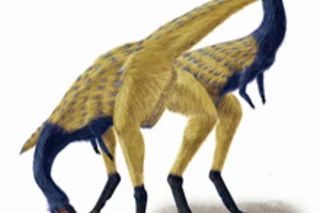Most paleontologists believe that a group of dinosaurs evolved into today's birds, but in trying to understand that gradual process they've been bedeviled by some details. Yesterday, researchers announced that they may have solved one of those small conundrums. A fossilized dinosaur found in China appears to settle the matter of exactly how the bones in dinosaurs' feet evolved into the digits hidden in bird wings. The newly discovered ceratosaur belonged to a group of dinosaurs called theropods, which are thought to have given rise to modern birds and which included the mighty Tyrannosaurus rex. But unlike its T. rex cousin, this ceratosaur appears to have been a vegetarian. Says study coauthor James Clark:
"It's a really weird animal - it's got no teeth, had a beak and a very long neck, and very wimpy forelimbs.... Then when we looked closely at the hand, we noticed it was relevant to ...














